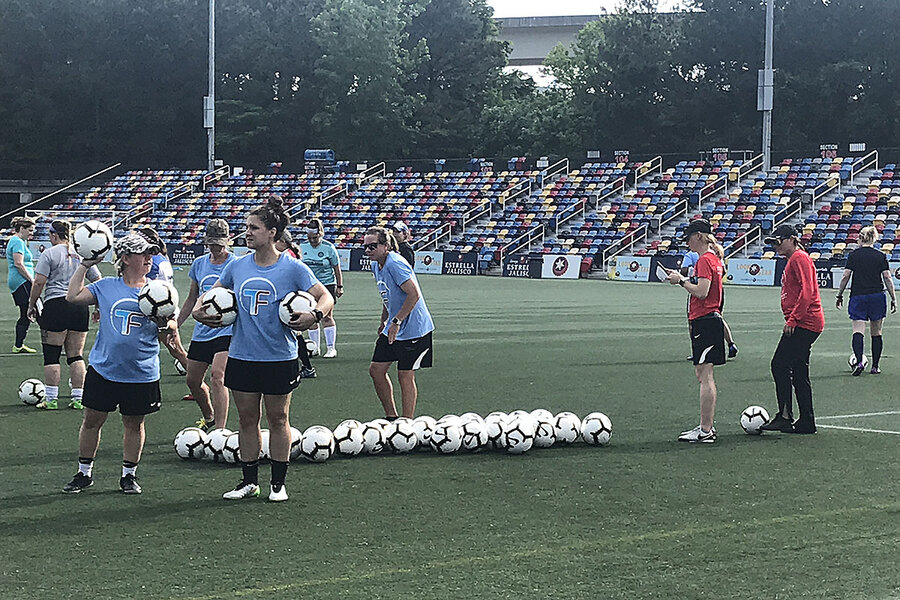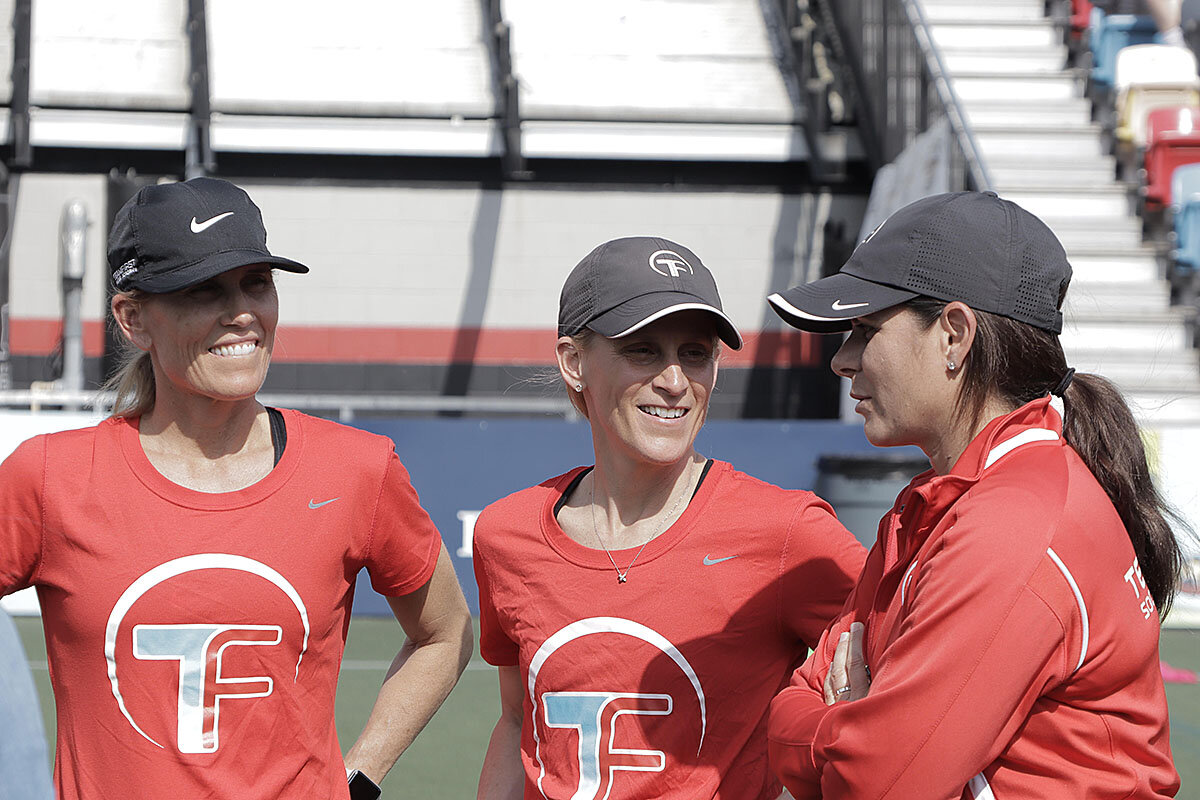Kicking it with Mia Hamm: My day with women’s soccer royalty
Loading...
| Atlanta
I’m doing my best at left defense at the Atlanta Silverbacks soccer stadium. A woman (20 years my junior) is hurtling toward me with the ball, her hair streaking out behind like the tail on a racehorse. I size her up; I decide I can take her. I step up and strike the ball with the inside of my right foot. The ball stops, and momentarily so does the play as the impact of the block throws me off balance and ... I crash to the turf.
She takes off with the ball, but within moments our center defender is sending it back to me. I look up to make a pass. I see Kristine Lilly – yes, soccer legend Kristine Lilly – waving at me from midfield, wide open. Before I lose my nerve, I send her a pass in the air. She lifts her knee and gently settles the ball to the ground with her foot. The play surges toward the other goal.
I raise my hand for a sub. It’s been 2 minutes and 10 seconds, and I’m exhausted.
Why We Wrote This
For most of us, heroes dwell in an untouchable realm. But this month, our reporter got the chance of a lifetime to share the soccer pitch with Mia Hamm, Kristine Lilly, and Tisha Venturini Hoch.
This is not a dream. I’m at an adult women’s soccer fantasy camp with Ms. Lilly and fellow World Cup champions Mia Hamm and Tisha Venturini Hoch. I’m here with 55 other campers ranging in ages from 23 to 63, and we are ready to party like it’s 1999.
Most professional sports fantasy camps, where participants can get coaching and autographs from the pros, last from three to five days and can cost $3,000 to $10,000. But the target audience is middle-aged men. Few are intended for or coached by women.
So when Ms. Lilly tweeted an announcement for a three-hour women’s soccer fantasy camp for $150 in Atlanta, I immediately began booking my flights.
It’s been 20 years since the United States women’s national soccer team defeated China in a nail-biting penalty-kick shootout, when Brandi Chastain ripped off her shirt in victory, and the record-breaking 90,185 fans at the Rose Bowl Stadium shattered the moon with their cheers.
Today, many of the ’99ers are still involved in efforts to grow the sport. Ms. Lilly, Ms. Hamm, and Ms. Venturini Hoch formed TeamFirst Soccer Academy and offer clinics for girls and young women around the U.S. The children they coach at the clinics barely recognize them as soccer royalty, even though Ms. Lilly remains the most experienced international soccer player (male or female) of all time.
But waves of parents still ask for autographs, and they are the reason for the TeamFirst fantasy camp. They are the ones who first pinned posters of the women’s national team on their bedroom walls. This is what I am thinking about as I pull into the parking lot and a familiar pregame feeling settles over me: I want to throw up.
I played soccer for nearly three decades, but it’s been at least six years since I touched a ball in competition. I step tentatively on the pitch to warm up. My borrowed socks and shinguards are pulled up high, my boots are stiff with age, and the waistband on my shorts feels a tad tight. I clutch my ball to my stomach, trying to settle my nerves.
Soon, a familiar voice commands us to get on the line. It’s Ms. Hamm dressed incognito as a soccer mom in long black pants, a long-sleeve red T-shirt, and a black cap low over her eyes.
“This is how the women’s national team warms up!” she bellows. We laugh nervously and then do a series of gentle runs and calisthenics. We’ve been at it for about 15 minutes and we are wilting. The coaches send us to the pavilion for staff introductions.
I meet Betsy, another camper, wearing a muscle shirt and a weathered tattoo across her right bicep. She tells me she’s been playing soccer for 40 years. She asks my vintage and sniffs, “You had the luxury of Title IX programs,” she says. “If we wanted to play soccer, we had to hunt it out.”
And then it’s back to the pitch. Ms. Hamm demonstrates some drills with the dexterity of a Las Vegas casino dealer. We cycle through stations and then scrimmage. I relax. I’m having fun even though my whole body hurts. Storm clouds gather and lightning forks the sky. We scurry under the pavilion for shelter and dinner. I chat up Michelle Akers, you know, the FIFA Female Player of the Century, over a bowl of tortilla chips. She had shown up as a surprise guest. I tell her I saw her play in an international friendly in 1995 in Decatur, Georgia, on a grassless field leading up to the World Cup in Sweden.
She fixes her steely gaze on my face. “Those ’91 and ’95 fans – those were the hard-core fans.”
I swell with pride.
Now it’s storytime, which feels like a giant sleepover with our soccer idols telling us one inside joke after another. Someone asks, do people still recognize you? Ms. Hamm grins.
The icon who once appeared on a Wheaties box and judo-flipped Michael Jordan in a Gatorade commercial now drives a carpool for her children and their friends as Mrs. Garciaparra, wife of former All-Star shortstop Nomar Garciaparra. She tells us about Angus, a young soccer player, who rides in the back. Ms. Hamm asked him if he’s going to watch the World Cup kicking off on June 7. “There is a World Cup this summer?” Yes, she replied, the Women’s World Cup in France. “They have that?” One of the other kids piped up, “She played in the World Cup!”
Angus paused thoughtfully and asked, “Did you know Mia Hamm?”
We laugh and our faces grow wistful. It’s almost time to leave.
A woman who looks to be about my age raises her hand. “I was in Atlanta for the ’96 Olympics, but I couldn’t afford a ticket,” she says. She watched as much as she could when the U.S. won gold – but NBC broadcast only a few minutes of the game. “I don’t actually have a question,” she says, folding a hand over her heart. “I just wanted to say thank you – for the memories.”







